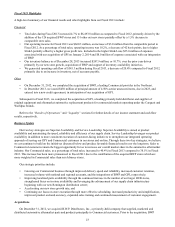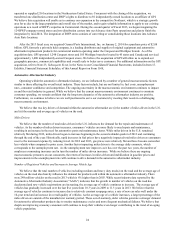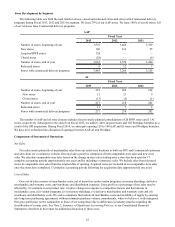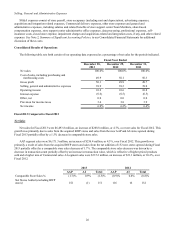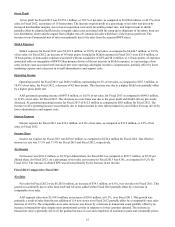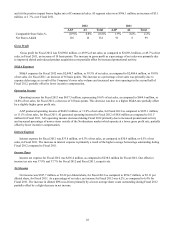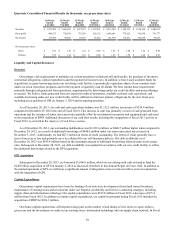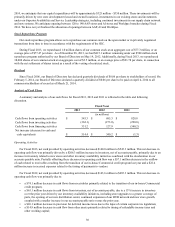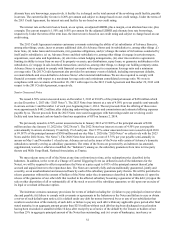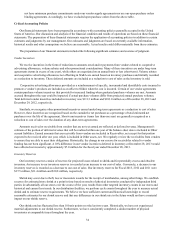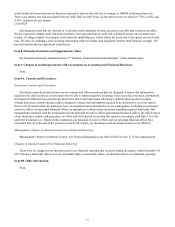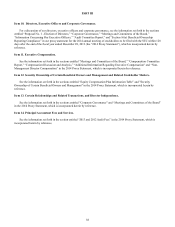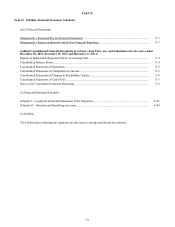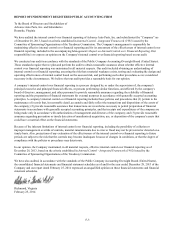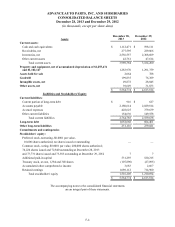Advance Auto Parts 2013 Annual Report Download - page 46
Download and view the complete annual report
Please find page 46 of the 2013 Advance Auto Parts annual report below. You can navigate through the pages in the report by either clicking on the pages listed below, or by using the keyword search tool below to find specific information within the annual report.
33
reorganization affecting us and certain of our subsidiaries. In the case of an event of default, the principal amount of the Notes
plus accrued and unpaid interest may be accelerated. The Indenture also contains covenants limiting the ability of us and our
subsidiaries to incur debt secured by liens and to enter into sale and lease-back transactions.
As of December 28, 2013, we had a credit rating from Standard & Poor’s of BBB- and from Moody’s Investor Service of
Baa3. The current outlooks by Standard & Poor’s and Moody’s are both stable. The current pricing grid used to determine our
borrowing rate under our revolving credit facility is based on our credit ratings. If these credit ratings decline, our interest rate
on outstanding balances may increase and our access to additional financing on favorable terms may become more limited. In
addition, it could reduce the attractiveness of our vendor payment program, where certain of our vendors finance payment
obligations from us with designated third party financial institutions, which could result in increased working capital
requirements. Conversely, if these credit ratings improve, our interest rate may decrease.
Off-Balance-Sheet Arrangements
As of December 28, 2013, we had no off-balance-sheet arrangements as defined in Regulation S-K Item 303 of the SEC
regulations. We include other off-balance-sheet arrangements in our contractual obligations table including operating lease
payments, interest payments on our notes and revolving credit facility and letters of credit outstanding.
Contractual Obligations
In addition to our Notes and revolving credit facility, we utilize operating leases as another source of financing. The
amounts payable under these operating leases are included in our schedule of contractual obligations. Our future contractual
obligations related to long-term debt, operating leases and other contractual obligations as of December 28, 2013 were as
follows:
Payments Due by Period
Contractual Obligations Total
Less than
1 Year 1 - 3 Years 3 - 5 Years
More Than
5 Years
(in thousands)
Long-term debt (1) $ 1,053,584 $ 916 $ 1,049 $ — $ 1,051,619
Interest payments 432,740 51,161 102,221 102,200 177,158
Operating leases (2) 2,441,925 353,508 616,447 546,495 925,475
Other long-term liabilities (3) 231,116 — — — —
Purchase obligations (4) 61,699 34,220 17,517 9,961 —
$ 4,221,064 $ 439,805 $ 737,234 $ 658,656 $ 2,154,252
Note: For additional information refer to Note 7, Long-term Debt; Note 15, Income Taxes; Note 16, Lease Commitments; Note
17, Contingencies; and Note 18, Benefit Plans, in the Notes to Consolidated Financial Statements, included in Item 15.
Exhibits, Financial Statement Schedules, of this Annual Report on Form 10-K.
(1) Long-term debt primarily represents the principal amount of our 2020 Notes, 2022 Notes and 2023 Notes, which
become due in Fiscal 2020, Fiscal 2022 and Fiscal 2023, respectively.
(2) We lease certain store locations, distribution centers, office space, equipment and vehicles. Our property leases
generally contain renewal and escalation clauses and other concessions. These provisions are considered in our
calculation of our minimum lease payments which are recognized as expense on a straight-line basis over the
applicable lease term. Any lease payments that are based upon an existing index or rate are included in our minimum
lease payment calculations.
(3) Primarily includes the long-term portion of deferred income taxes, self-insurance liabilities, unrecognized income tax
benefits, closed store liabilities and obligations for employee benefit plans for which no contractual payment schedule
exists and we expect the payments to occur beyond 12 months from December 28, 2013. Accordingly, the related
balances have not been reflected in the “Payments Due by Period” section of the table.
(4) Purchase obligations include agreements to purchase goods or services that are enforceable, legally binding and
specify all significant terms, including fixed or minimum quantities to be purchased; fixed, minimum or variable price
provisions; and the approximate timing of the transaction. Included in the table above is the lesser of the remaining
obligation or the cancellation penalty under the agreement. Our open purchase orders related to merchandise inventory
are based on current operational needs and are fulfilled by our vendors within a short period of time. We currently do


